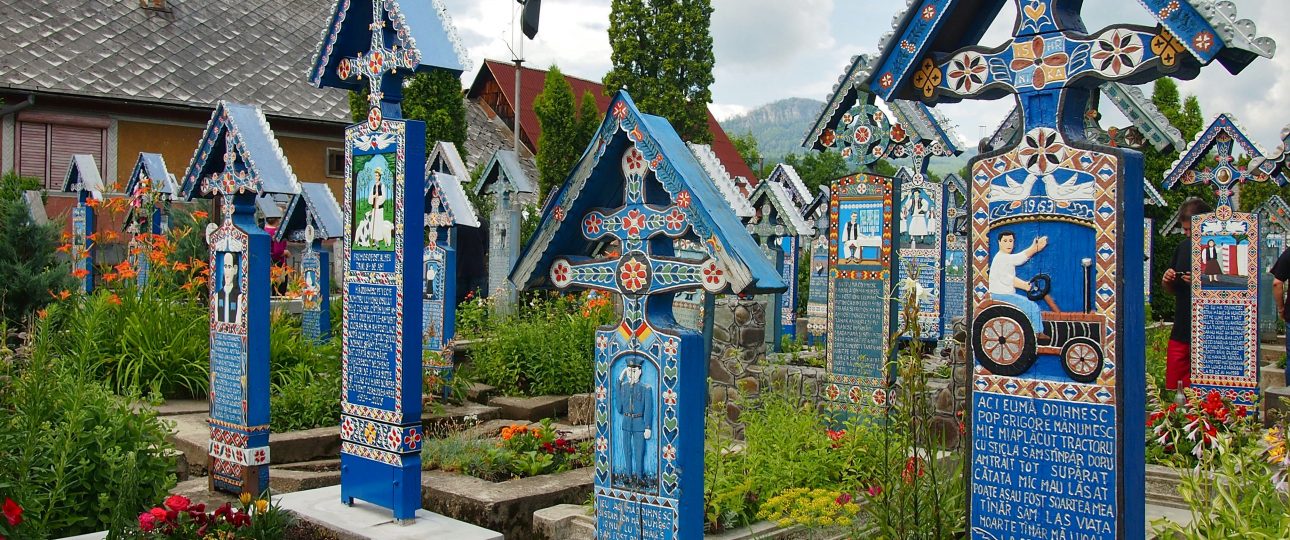Merry Cemetery – A Unique Folk-Art Cemetery in Săpânța, Romania
Location and Setting
The Merry Cemetery, known locally as Cimitirul Vesel, is situated in the village of Săpânța, Maramureș County, Romania. This region, near the Ukrainian border, is celebrated for its rich traditions, wooden churches, and picturesque rural landscapes.
Origins and History
The cemetery’s distinctive style began in 1935, initiated by Stan Ioan Pătraș, a local artist and woodcarver. Pătraș crafted the first colorful wooden crosses, each adorned with a humorous epitaph that captured the essence of the deceased’s life or death. By the 1960s, over 800 such crosses had been created. After Pătraș’s death in 1977, his apprentice, Dumitru Pop Tincu, continued this unique tradition.
The “Merry” Aspect
Despite being a burial site, the Merry Cemetery is far from somber. The vibrant blues, reds, and greens of the crosses stand in stark contrast to the typical gray of graveyards. Epitaphs, often written in the local dialect, provide a humorous or candid portrayal of the deceased, sometimes depicting their life stories or causes of death. This approach reflects a local belief that death is a continuation of life, not an end.
What to Expect
- Over 800 hand-carved and painted wooden crosses.
- Folk-art scenes illustrating the lives or deaths of those buried.
- Poetic epitaphs, often humorous, written in the first person.
- The workshop of Stan Ioan Pătraș, now a museum.
- The nearby Church of the Assumption, a candidate for UNESCO World Heritage status.
Visitor Information
Opening Hours: The cemetery is open daily, typically from 9:00 AM to 6:00 PM, though hours may vary seasonally.
Admission: A small entry fee of around 10 RON is usually required. Guided tours are available in Romanian and occasionally in English.
Photography: Allowed, but visitors should remain respectful as it is an active cemetery.
Getting There
By Air: The nearest major airport is Cluj-Napoca International Airport, approximately 220 km away. Baia Mare Airport is closer but offers limited connections.
By Train: Travel to Sighetu Marmației, about 20 km from Săpânța, and then take a taxi or local minibus.
By Car: Renting a car from Cluj or Baia Mare provides the most flexibility. Roads are generally in good condition.
Accommodation
Visitors can choose from guesthouses in Săpânța or small hotels in Sighetu Marmației. Many local pensions offer home-cooked meals and insights into Maramureș traditions.
Best Time to Visit
The ideal months to visit are from May to September, when the weather is pleasant and the region hosts various traditional festivals. Winter visits are possible but can be cold and snowy, especially in rural areas.
Visitor Tips
- Bring cash, as many local establishments do not accept cards.
- Consider hiring a local guide to fully appreciate the epitaphs’ meanings.
- Visit the Pătraș Memorial House to learn more about the cemetery’s origins.
Key Facts
- Location: Săpânța, Maramureș County, Romania.
- Established: 1935 by artist Stan Ioan Pătraș.
- Features: Painted wooden crosses, humorous epitaphs, and folk-art scenes.
- Entry Fee: Approximately 10 RON (subject to change).
- Nearest Town: Sighetu Marmației (20 km).
- Best Time to Visit: May to September.




